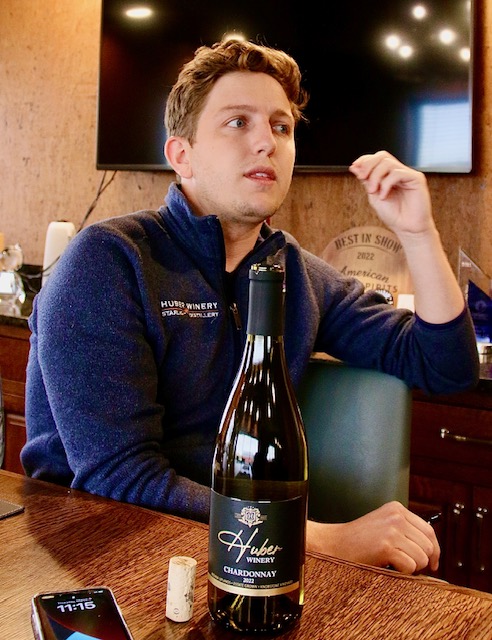AUTHOR’S NOTE: This is a piece I write quarterly for Madison Magazine, East Central Indiana. This column on Indiana’s first Chardonnay was published earlier this year.
Passing a successful business down through generations is the American story. The choice for each new generation is to keep things the same or go new directions.
When it comes to Indiana wineries no one is making big change like the young brothers at Huber Winery. The winery, with its history on a hill in southern Indiana, is known as the best Indiana vineyard site. Christian and Blake Huber are going boldly into new areas for an Indiana winery. They have planted and are making Chardonnay!

That may not sound so bold but considering there is no Chardonnay grown in Indiana, it’s groundbreaking. There is a hybrid that is similar called Chardonel. It’s generally insipid. The two graduated from prominent viticulture schools..
“To my knowledge no one else has tried to plant Chardonnay,” Christian Huber said. “Indiana has been known for bulk, sweet wine. I love to say sweet wine built our family’s legacy and it’s built out our distillery. It’s paid for so much stuff for us here on the property.”
Jill Blume, enology specialist for Purdue’s Wine and Grape team, said Huber’s is probably the only winery in Indiana that has successfully grown vinifera grapes. “Other wineries and grape growers have tried to duplicate Huber’s success, but it just hasn’t panned out, she said. “Huber’s are on a special point, terroir, KNOB which has spared them from the extremely low winter temperatures that have been so detrimental, even to hybrids like Traminette.”
The secret to Huber’s success and future is its unique location. “We are one of the highest points in Indiana, about 900 ft. above sea level,” Blake said “We’re sitting right on an escarpment where the glaciers went through. We have very diverse soil composition.”
They continue to look at growing patterns and growing degree days. If you don’t believe in climate change, ask a farmer.
“The vineyards of Indiana are warming up,” Christian said. “The climate is getting better for vinifera – often defined as old world grapes: Chardonnay, Cabernet, Cabernet Franc, etc.

Indiana is dominated by hybrid grapes Traminette, Chambourcin and many others. “One of our biggest hurdles is we’re in the Midwest and people just don’t want to drink wine from the Midwest.”
It won’t stop with Chardonnay.. It’s not so simple as tearing out a vineyard and putting in new vines. The brothers studied the soils on the sprawling Huber property for more than two years until they found a spot they liked. A frost killed off most of the vines in 2019 and the process started all over again. Finally, they had a small 2021 harvest and made about 100 cases of wine. Consumers approved by snapping the Chardonnay up in about 3-4 months. There was no announcement, promotion or distribution.
The 2022 crop was twice as large and should be 250-300 cases. During my March visit the bottling lines were busy with the new vintage. The wine, just 2 hours removed from the production line, was unlike anything I had tasted in Indiana, and was much more like a lower-tier White Burgundy. And for the wine geeks, the Chardonnay was varietally correct.
The first harvest produced 2-2.5 tons per acre; 2022 was much closer to norm at about 4 tons per acre.
The current generation, father Ted, was skeptical. “My Dad called me crazy when we first started,” Christian admitted. “He said it’s something that’s really hard to grow. It’s going to be really low yield.” He also told his sons their price of $24.99 was “crazy.”
It doesn’t stop with Chardonnay. The brothers anticipate starting Sauvignon Blanc vines as early as 2024. Merlot, Riesling, and Syrah are likely to follow. They will also plant more of their very successful Cabernet Franc. I’ve called the Cab Franc Indiana’s best red wine.
This new generation has learned from family legacy, their education and their Dad. They’re ready to take Huber’s legacy and build their own.
